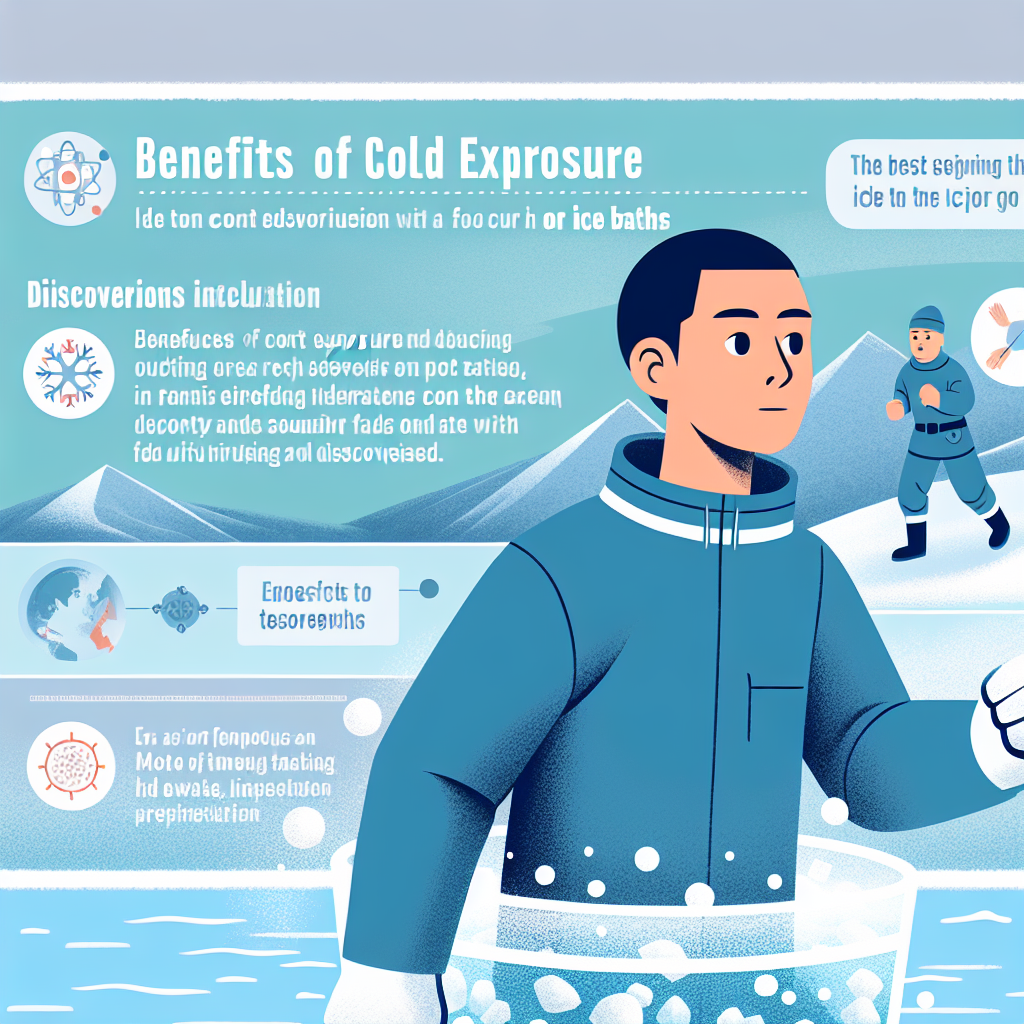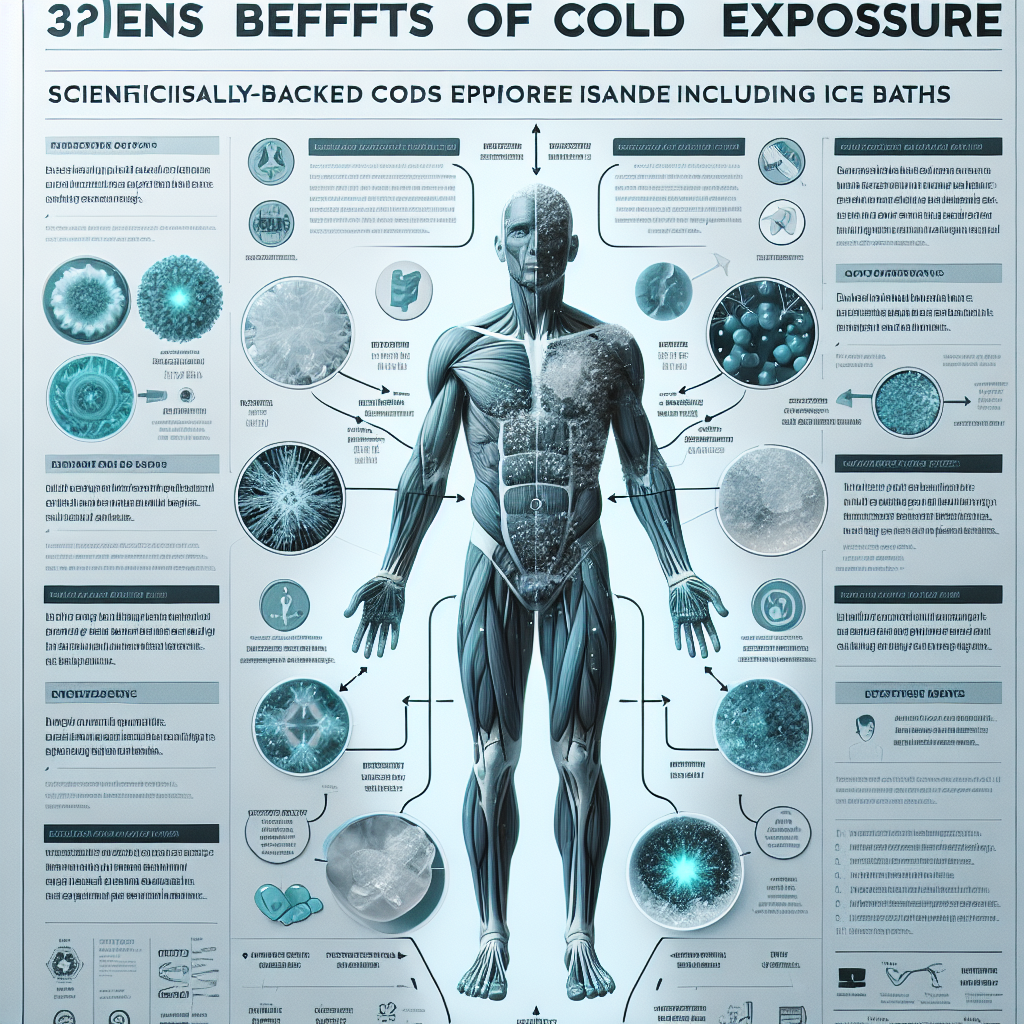Cold Exposure Benefits: Unlocking the Science Behind Ice Baths

Discover the science behind the benefits of cold exposure and unlock the secrets of ice baths. Enhance your health and wellness today. Visit www.myvibrantvitality.com to learn more.
Exploring the Health Advantages of Cold Exposure: The Science Behind Ice Baths
Cold exposure, particularly in the form of ice baths, has been a long-standing practice among athletes and fitness enthusiasts. However, it is only recently that the scientific community has begun to delve into the potential health benefits of this seemingly extreme practice. The science behind ice baths is fascinating, revealing a host of potential benefits that extend beyond the realm of sports and fitness.
The principle behind cold exposure, or cryotherapy, is simple: when the body is exposed to cold temperatures, it responds by constricting blood vessels to conserve heat. This process, known as vasoconstriction, reduces inflammation and swelling, making it particularly beneficial for athletes recovering from intense workouts or injuries. Once the body rewarms, the blood vessels dilate, increasing blood flow and delivering oxygen and nutrients to the muscles and tissues. This process, known as vasodilation, aids in recovery and repair.
However, the benefits of cold exposure extend beyond muscle recovery. Research suggests that regular cold exposure can boost the immune system. A study published in the journal PLoS One found that individuals who took cold showers reported fewer sick days than those who took hot showers. The researchers hypothesized that the cold exposure stimulated the immune system, increasing the production of white blood cells.
Moreover, cold exposure may also have a positive impact on mental health. A study published in the journal Medical Hypotheses found that cold showers could be an effective treatment for depression. The researchers suggested that the cold water could stimulate the production of endorphins, the body’s natural “feel-good” chemicals, and send an overwhelming amount of electrical impulses to the brain, which could have an antidepressant effect.
Another intriguing area of research is the potential for cold exposure to aid in weight loss. The human body has two types of fat: white fat, which stores energy, and brown fat, which burns energy to generate heat. Studies have shown that cold exposure can stimulate the production of brown fat, potentially aiding in weight loss. A study published in the Journal of Clinical Investigation found that individuals who were exposed to cold temperatures for two hours a day for six weeks experienced a significant increase in brown fat activity and a corresponding decrease in body fat.
Despite these potential benefits, it’s important to note that cold exposure, particularly in the form of ice baths, is not for everyone. Individuals with certain health conditions, such as heart disease or Raynaud’s disease, should avoid cold exposure. Additionally, it’s crucial to gradually acclimate the body to the cold, starting with shorter exposures and gradually increasing the duration.
In conclusion, the science behind ice baths is revealing a host of potential health benefits, from improved muscle recovery and immune function to potential benefits for mental health and weight loss. However, as with any health practice, it’s important to approach cold exposure with caution and under the guidance of a healthcare professional. As research continues to unfold, it’s clear that this age-old practice may have more to offer than meets the eye.
Unlocking the Mysteries of Cold Therapy: The Benefits of Ice Baths

Cold exposure therapy, particularly in the form of ice baths, has been gaining popularity in recent years. This practice, once reserved for elite athletes, is now being embraced by a wider audience seeking to unlock the myriad of health benefits it promises. The science behind this chilly practice is fascinating, revealing a host of physiological responses that can contribute to improved health and well-being.
The principle behind cold exposure therapy is simple: by immersing the body in cold water, you stimulate the body’s natural response to cold, which can have a range of beneficial effects. One of the most immediate and noticeable effects of an ice bath is the stimulation of blood circulation. When the body is exposed to cold, it responds by constricting blood vessels in the skin and extremities. This constriction pushes blood towards the core to maintain body temperature, and when you warm up again, the blood rushes back, helping to flush out toxins and metabolic waste from your muscles.
This enhanced circulation can have a number of positive effects on the body. For athletes, it can help speed up recovery after intense workouts by reducing inflammation and muscle soreness. But the benefits aren’t limited to those who engage in strenuous physical activity. Improved circulation can also contribute to better skin health, as it helps deliver nutrients to the skin while removing waste products.
Another significant benefit of cold exposure therapy is its impact on the body’s metabolic rate. Research has shown that regular exposure to cold can increase the body’s metabolism, as it works harder to maintain its core temperature. This can lead to an increase in calorie burn, which can be beneficial for weight management. Moreover, cold exposure has been found to stimulate the production of brown fat, a type of fat that actually burns calories to generate heat, further contributing to increased metabolism.
Cold exposure therapy can also have a profound effect on mental health. The initial shock of the cold can stimulate the production of endorphins, the body’s natural mood elevators. This can lead to feelings of euphoria and positivity, helping to combat stress and anxiety. Additionally, the practice of regularly immersing oneself in cold water can help build mental resilience, as it requires a certain level of mental fortitude to overcome the initial discomfort.
Lastly, cold exposure therapy can contribute to improved sleep. The body’s core temperature naturally drops at night to facilitate sleep, and a cold bath can help kickstart this process. This can lead to deeper, more restful sleep, which is crucial for overall health and well-being.
In conclusion, the science behind cold exposure therapy reveals a host of potential benefits, from improved circulation and metabolism to enhanced mental health and sleep quality. While the practice may be uncomfortable at first, the potential rewards make it worth considering. As with any new health practice, it’s important to approach it responsibly and consult with a healthcare professional if you have any underlying health conditions. The mysteries of cold therapy are being unlocked, and the benefits of ice baths are becoming increasingly clear.
The Power of Cold: Unveiling the Scientific Benefits of Ice Baths
The power of cold exposure, particularly in the form of ice baths, has been a topic of interest for many years. Athletes, wellness enthusiasts, and scientists alike have been intrigued by the potential benefits of this seemingly harsh practice. As we delve into the science behind ice baths, we find that the benefits are not only real but also quite extensive.
The human body is a complex system that responds to various stimuli in different ways. Cold exposure, for instance, triggers a series of physiological responses that can have significant health benefits. One of the most immediate effects of cold exposure is vasoconstriction, the narrowing of blood vessels. This response reduces blood flow to the skin and extremities, thereby conserving body heat. However, once the cold stimulus is removed, the blood vessels dilate, increasing blood flow and oxygen supply to the muscles and organs. This process, known as cold-induced vasodilation, can help flush out toxins and metabolic waste, reduce inflammation, and speed up recovery after intense physical activity.
Moreover, cold exposure has been found to stimulate the production of brown adipose tissue, commonly known as brown fat. Unlike white fat, which stores excess calories, brown fat burns energy to generate heat, thereby increasing metabolic rate and promoting weight loss. A study published in the Journal of Clinical Investigation revealed that regular cold exposure could increase brown fat activity by up to 15 times, leading to an additional nine pounds of weight loss per year.
In addition to physical benefits, ice baths can also have psychological effects. The initial shock of cold water can trigger a stress response, releasing adrenaline and endorphins, the body’s natural painkillers. This response can lead to feelings of euphoria and increased mental clarity, similar to the “runner’s high” experienced by endurance athletes. Furthermore, regular cold exposure can enhance stress resilience, as the body becomes better at managing stress over time.
However, it’s important to note that while the benefits of ice baths are promising, they are not without risks. Immersion in cold water can cause a sudden drop in body temperature, leading to hypothermia if not properly managed. It’s also not recommended for individuals with certain health conditions, such as heart disease or Raynaud’s disease, as it can exacerbate symptoms. Therefore, it’s crucial to consult with a healthcare professional before incorporating ice baths into your wellness routine.
In conclusion, the science behind ice baths reveals a myriad of benefits, from enhanced recovery and weight loss to improved mental clarity and stress resilience. However, like any health practice, it’s essential to approach it with caution and under professional guidance. As we continue to unlock the secrets of our body’s response to cold, we can look forward to discovering even more ways to harness the power of cold for our health and wellbeing.